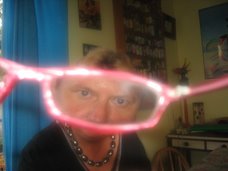Keeping eye on southern sky
 By VIRGINIA WINDER
By VIRGINIA WINDERA BUNCH of Taranaki amateur astronomers have landed the job of patrolling the southern sky as part of an international collaboration.
The flipside is that astronomers at the Jarnac Observatory in Vail, Arizona, will also be able to check out the sky Down Under. And vice versa.
The night watchers, including comet spotter Rodney Austin, have been donated a $13,000 telescope (pictured) by American astronomer David Levy and his wife Wendee, plus the National Sharing the Sky Foundation.
Levy is a bright star in astronomy, especially because of his comet spotting. He has found 22 of the long-tailed icy gas-and-dust trails.
Together with Eugene and Caroline Shoemaker, he discovered Shoemaker-Levy 9. That’s the comet that collided with Jupiter in 1994, producing the most spectacular explosions ever witnessed in the solar system.
Austin says the brand new 14-inch Ritchey-Chretien reflector telescope touched down about a month ago.
“It came out of the blue,” he says.
Just like the offer of the telescope, made by Meade in the US.
Last year, Levy was a keynote speaker at the Royal Astronomical Society of New Zealand conference in New Plymouth.
 “David fell in love with the place,” says Austin (pictured). “There wasn’t a cloud over the province for 10 days. We got talking one day and he said ‘we have this foundation and we would like you to have one of these telescopes’.”
“David fell in love with the place,” says Austin (pictured). “There wasn’t a cloud over the province for 10 days. We got talking one day and he said ‘we have this foundation and we would like you to have one of these telescopes’.”From Vail, Levy tells his version.
“We were very impressed with the enthusiasm of the people there during our visit in June and July of 2006,” he says.
“And then after we returned to the US, we tried letting them have a remote observing session with our telescope here in Arizona. That also was successful. We thought that collaboration would be beneficial.”
Levy explains why. “They get a nice telescope with which they can observe the southern sky and we hopefully get to use it remotely once the details are worked out.”Using an internet programme, the Taranaki team gets the opportunity to look at the flipside of space.
“They should be able to make Northern Hemisphere observations as well,” Levy says.
Austin says the remote observing, including the practice session, is a breakthrough for Kiwi amateur astronomers.
“As a training run, during a massive thunderstorm we had here, a group of us operated David Levy’s telescope in Arizona by remote control. As far as we know that was the first time in New Zealand that a bunch of amateurs operated a telescope overseas remotely.”
The donation is another first. “There have only been four telescopes donated so far, and we are the only ones outside the United States,” Austin says.
The Taranaki telescope is to be housed at a secret location in north Taranaki. Austin says to keep whereabouts of the star-watching instrument safe, its whereabouts cannot be revealed.
But this is not a closed-scope affair.
“It’s not going to be a visual telescope – it’s going to have a camera,” he says. “It will take images. The idea of the project is we will use it to patrol the southern sky looking for new comets and asteroids, which are bits of rock in the orbit around the sun,” he says of the latter.
It was also be able to record novae and supernovae (exploding stars) and minor planets. The stargazers then go over the photographs taken, looking for changes in planets and any foreign bodies.
While it’s not officially a New Plymouth Astronomical Society project, members are involved and those who have expertise will be able to contribute, he says.
Housing for the telescope is still being built, but it’s expected to be up-and-scanning by summer. Then the universe will be at their fingertips.

No comments:
Post a Comment